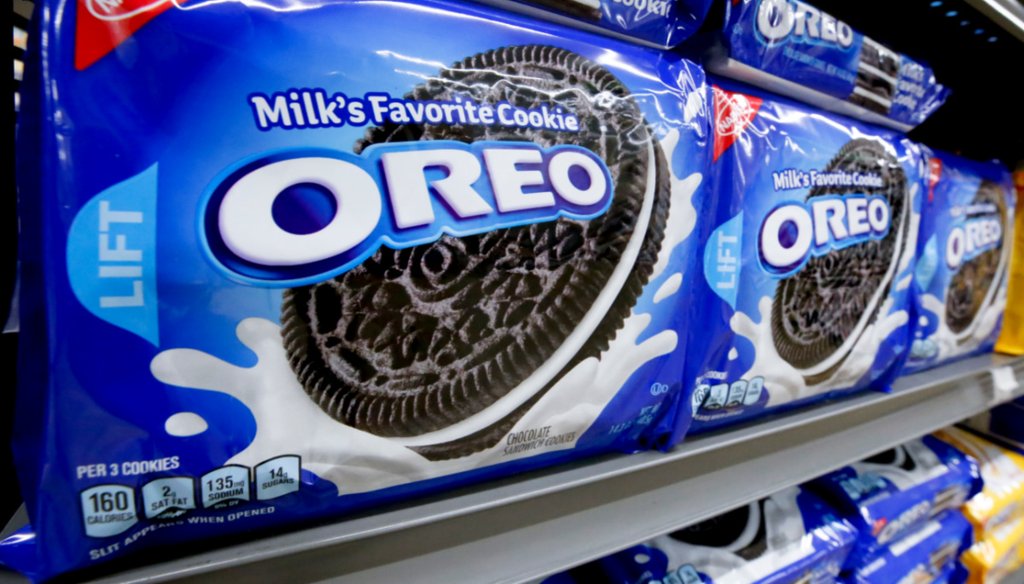

Our only agenda is to publish the truth so you can be an informed participant in democracy.
We need your help.


A packages of Oreo cookies sit on a market shelf, Aug. 8, 2018. Despite a claim to the contrary, no — Oreo cookies and other snacks don't contain human bones and teeth.(AP)
Human teeth and bones that are ground into calcium phosphate ash after undergoing alkaline hydrolysis, an alternative process to burial or cremation, are not added to food. The U.S. Food and Drug Administration prohibits the use of human remains in food products, according to a spokesperson.
The 2017 video footage shows the alkaline hydrolysis process at the University of California, Los Angeles’ Donated Body Program. The ashes from bodies donated to that program were spread off the coast of Camp Pendleton in California.
Some people dip Oreo cookies in milk, a known source of calcium that can help strengthen bones. But one Facebook reel wants you to believe there are already pulverized human bones in those cookies.
The video, posted May 3, showed a person dressed in scrubs demonstrating how he processed bones from human remains in a cremulator, which then turned them into ash.
"Ground up ash actually looks just like this when it’s all done, so it’s fine white, pure white calcium phosphate is what we’re looking at," he said, holding up a bag of ash. The video then cuts to photos of packages of Oreo cookies, Ritz toasted chips, graham crackers and Kool-Aid with their ingredient lists, which include calcium phosphate.
Text on the video reads: "The government has been putting ground up HUMAN BONE & TEETH in our food call it ‘CALCIUM PHOSPHATE,’" and, "The government is putting dead people REMAINS IN OUR FOOD PRODUCTS." It also says, "The food in the pictures do contain dead peoples REMAINS."
The reel was flagged as part of Facebook’s efforts to combat false news and misinformation on its News Feed. (Read more about our partnership with Meta, which owns Facebook and Instagram.)
The foods featured in the video contain calcium phosphate in their ingredient lists, but it is not derived from human remains — it is from naturally occuring minerals. The video does not say that human remains are added to food, and we found no evidence to support it.
Similar videos posted on TikTok have amassed more than 6.5 million views.
The Facebook video isn’t proof of a government plot to add pulverized bones and teeth to food. It comes from an August 2017 video from Wired UK about alkaline hydrolysis, an alternative process to burial or cremation, which featured Dean Fisher, then-director of the Donated Body Program at the University of California, Los Angeles’ David Geffen School of Medicine. Wired also published a 2018 report about alkaline hydrolysis. Once a donated cadaver had been dissected, Wired wrote, Fisher used an alkaline hydrolysis machine to turn it into dried bone and liquid.
Alkaline hydrolysis uses water, chemicals and heat to accelerate the decaying process. It’s viewed as an environmentally friendly alternative to burial and cremation, the Cremation Association of North America writes.
Fisher showed Wired how the process worked. When the alkaline hydrolysis processing of the body was complete, the bones, teeth and any remaining metals were separated. The bones and teeth were then ground to ash. The story said the ash was scattered off the coast of Camp Pendleton, a U.S. Marine Corps base in Oceanside, California — not added to food.
The remaining liquid becomes sterile through the process. No human DNA is left — by the time it’s drained into wastewater, only salts, sugars, amino acids and peptides remain, the Cremation Association of North America states.
Calcium phosphate is a naturally occurring mineral, a compound composed of calcium and phosphorus that is found in bones and teeth, according to Medical Today. "The development of phosphates as food additives took place between 1930 (and) 1960," reports BAKERPedia, an online food and baking resource. "They occur naturally in rocks. Commercially, it is made from phosphorus rock and calcium salts with phosphoric acid."
"The FDA prohibits the use of human remains in food products," U.S. Food and Drug Administration spokesperson Courtney Rhodes told USA Today in March.
"The agency’s regulations state that any food product that contains non-food materials, including human remains, is considered adulterated and cannot be sold or distributed for consumption," she said in a statement to the newspaper.
We rate the claim that "the government has been putting ground up human teeth and bone in our food and calling it 'calcium phosphate’" Pants on Fire!
Facebook reel, May 3, 2023
TikTok posts, accessed May 16, 2023
The future of death: Inside the machine that dissolves corpses | WIRED Originals, August 15, 2017
Wired, A new way to dispose of corpses—with chemistry! March 27, 2018
Smithsonian magazine, Could water cremation become the new American way of death? July 27, 2022
Cremation Association of North America, Alkaline hydrolysis, accessed May 12, 2023
Medical News Today, What to know about calcium phosphate, accessed May 12, 2023
USA Today, Fact check: No, aquamation remnants are not used to 'feed the dead to the living', March 30, 2023
BAKERPedia, Calcium Phosphate, May 16, 2023
In a world of wild talk and fake news, help us stand up for the facts.
